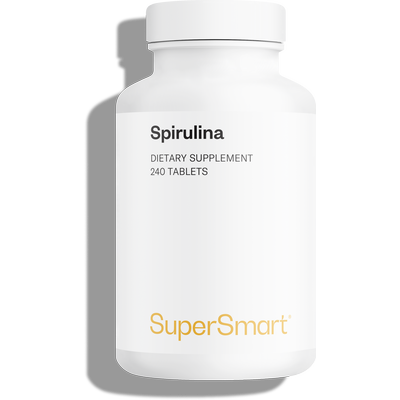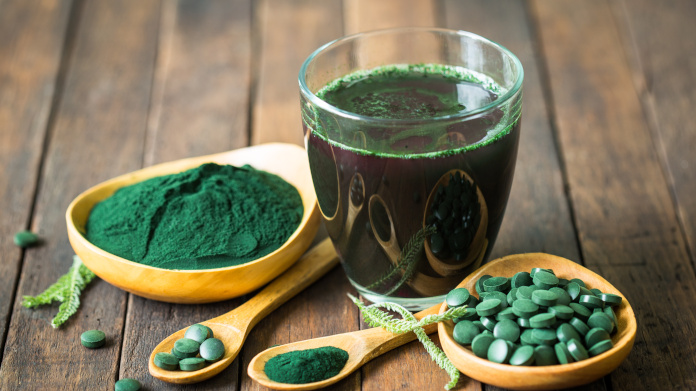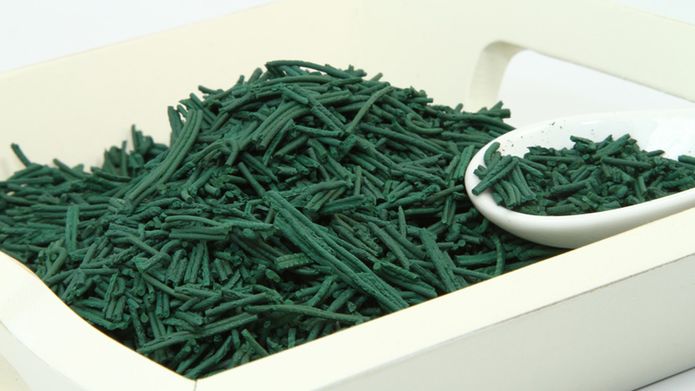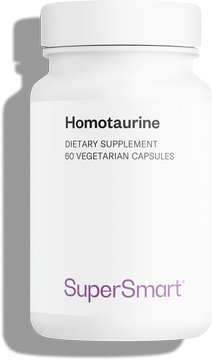Phycocyanin, spirulina's blue secret: benefits & dangers
Have you ever heard of the mysterious blue pigment that is phycocyanin? Particularly rare in the living world, it is now one of the most promising therapeutic molecules of the decade. If you eat spirulina, you've already come across it without even knowing it... Find out more about its benefits and risks.

What are the benefits of phycocyanin, the key compound in spirulina?
Definition of phycocyanin
Phycocyanin is a natural pigment that gives spirulina its intense, vibrant blue colour, which is very rare in the living world.
Along with chlorophyll, it allows spirulina to capture sunlight and transform it into electro-biochemical energy. But behind this mysterious blue colour lies one of the molecules of the 21st century.
Today, phycocyanin, which accounts for more than 20% of spirulina's weight, is raising huge hopes in medical research.
Firstly, because its unique structure gives it multiple potential effects on human health. Secondly, because it has natural fluorescent properties, potentially very useful in medical imaging. Finally, because it has the capacity to replace synthetic food colourings, whose potential long-term side-effects are regularly the subject of debate.
Studied benefits of phycocyanin
The potential health benefits of phycocyanin currently being studied by the scientific community are:
- its contribution to the natural antioxidant system. Multiple mechanisms of action are thought to be involved, including a reduction in the production of reactive oxygen derivatives (RODs), which are known to play a harmful role in excess (1);
- its influence on the integrity of the immune system. The potential dynamisation of the thymus, which plays an important role in cellular immunity by promoting the activity of white blood cells, is currently under study (2);
- its anti-inflammatory properties. In particular, phycocyanin is thought to help inhibit the expression of certain enzymes involved in the inflammatory process, such as cyclooxygenase-2 (COX-2) and nitric oxide synthetase (3);
- its effects on cell apoptosis (programmed cell death). This is a very promising avenue, which has led to the experimental use of phycocyanin as a complementary agent to chemotherapy (4-5).
Most of these effects are still being studied, but as results are published, one idea is gaining ground: most of the benefits claimed for spirulina could be linked to phycocyanin.
And the market has taken notice: studies estimate that the demand for phycocyanin will reach 233 million dollars in 2028, compared with just 122 million in 2018 (6).
Where can you find phycocyanine?
Like other phycobiliproteins, the family to which it belongs, phycocyanin is a rare molecule.
Only three types of living being contain it:
- cyanobacteria (formerly known as ‘blue-green algae’), such as Spirulina and Aphanizomenon flos-aquae (AFA);
- glaucophytes, a small, discrete group of single-celled algae found in freshwater environments;
- red algae, which contain much less. Fermentation cultures of the red micro-algae Galdieria Sulphuraria are being developed to produce phycocyanin in a different way.
For the time being, spirulina remains the best option for taking full advantage of phycocyanin's potential.
What are the other benefits of spirulina, the leading source of phycocyanin?
Basic facts about spirulina
Often presented as a micro-algae, spirulina is in fact a microscopic bacterium (cyanobacterium) of the genus Arthrospira.
The misunderstanding arises because it grows in brackish water, where it forms slimy filaments.
These bacteria grow best in warm, salty lakes (which also contribute to their blue-green colour), such as Lake Chad in central Africa and Lake Sambhar in India.
The Aztecs harvested large quantities in the ancient lakes of Mexico and consumed them in the form of dried cakes.
The health benefits of spirulina
The benefits of spirulina go far beyond those of phycocyanin.
Spirulina is generally recognised as an antioxidant, immunostimulant and anti-inflammatory substance, as well as being invigorating, slimming (because it promotes satiety), detoxifying and highly nutritious.
This cyanobacterium contains large quantities of high-quality protein (2.5 g to 3.5 g of protein per 5 g), a variety of antioxidants (lutein, zeaxanthin, cryptoxanthin, etc.), beta-carotene, a precursor of vitamin A (12,000 to 25,000 IU per 5 g), iron (3 to 8 mg per 5 g) and gamma-linolenic acid, an essential fatty acid (around 50 mg per 5 g).
Spirulina is particularly recommended for:
- athletes
- vegetarians and vegans (particularly for its high protein content, but not for its vitamin B12 content, as the form of B12 contained in spirulina is not biologically active in humans)
- growing children and teenagers
- people who are stressed and overworked
- convalescents and people suffering from chronic fatigue
- senior citizens
How do I choose my spirulina supplement?
You can, of course, take spirulina in powder form and in bulk (generally at low cost), as it is a food.
However, it is easier to store, transport and maintain stable doses over time in the form of a food supplement in capsules.
If you opt for spirulina capsules, which are a source of phycocyanin, make sure that the cultivation, drying and production conditions are good, by consulting the certificate of analysis.
Spirulina must be tested for microcystin, β-N-Methylamino-L-alanine and heavy metals.
Only certain supplements meet these various conditions, guaranteeing both effectiveness and safety (this is the case with the Spirulina food supplement, whose ingredients are supplied by the world's leading spirulina producer, Parry Organic Spirulina).
Can phycocyanin and spirulina be dangerous?
Spirulina and phycocyanin are widely consumed and studied
There are several species of spirulina, but A. platensis, A. maxima and A. fusiformis are considered to be the safest for human consumption.
The many toxicological studies carried out on spirulina have not revealed any acute or chronic toxicity, nor any teratogenic or genotoxic effects.
In fact, spirulina is now one of the most widely sold food supplements in shops and on the Internet.
Health safety agencies regularly receive reports about spirulina, but the side effects observed always depend exclusively on the growing conditions: certain extracts sometimes contain too many heavy metals, such as lead or cadmium, because the growing environment is polluted.
To avoid this, always select recognised manufacturers and sellers, and supplements that clearly mention the presence of spirulina rather than 'blue-green algae'.
Furthermore, no study has been able to show any toxicity from the more specific administration of phycocyanin.
Contraindications for spirulina
There are a few contraindications to bear in mind.
People suffering from phenylketonuria (a rare genetic disease caused by an enzyme deficiency that prevents the breakdown of phenylalanine, an amino acid found in spirulina) or people allergic to spirulina must avoid taking spirulina.
Spirulina is also not recommended in cases of autoimmune diseases or gout. It should not be taken during pregnancy without medical advice.
SUPERSMART ADVICE
References
- Pleonsil P., Soogarun S., Suwanwong Y. Antioxidant activity of holo- and apo-c phycocyanin and their protective effects on human erythrocytes. Int J Biol Macromol 2013; 60:393-8.
- Gupta M., Dwivedi UN., Khandelwal S. C-phycocyanin: An effective protective agent against thymic atrophy by tributyltin. Toxic Let 2011; 204:2- 11.
- Romay C., Armesto J., Remirez D., Gonzαlez R., Ledon N., García I., Antioxidant and anti-inflammatory properties of C-phycocyanin from bluegreen algae. Inflam Res 1998; 47:36-41.
- Jiang L., Wang Y., Yin Q., Liu G., Liu Y., Huang H., Li B. Phycocyanin: A potential drug for cancer treatment. J Can 2017; 8:3416-29.
- Wang CY., Wang X., Wang Y., Zhou T., Bai Y., Li YC., Huang B. Photosensitization of phycocyanin extracted from Microcystis in human hepatocellular carcinoma cells: implication of mitochondria-dependent apoptosis. J Photochem Photobiol B Biology 2012; 117:70-9.
- BCC. Buisness communication company Phycocyanin Market: Food & Beverage Application to Hold Close to 85% Value Share Throughout the Forecast Period: Global Industry Analysis (2013- 2017) & Opportunity Assessment (2018 - 2028).
2 Days
The products I use are excel·lent
The products I use are excel·lent
ROSAS Josep Maria
10 Days
Delivery is prompt and I never saw a…
Delivery is prompt and I never saw a quality problem with the manufacturing. It is not possible to assess efficacy on a personal basis, since too many factors come into play. Efficacy can only be assessed statistically with a sufficient number of cases.
Roger De Backer
11 Days
I collaborates with the Supersmart…
I collaborates with the Supersmart more than 10 years. Every thing is going good. Quality of the things is good. Delivery comes in time. Five stars definitely !!!
Oleksiy
11 Days
All good
Simple, frictionless site, easy ordering, good delivery updates and execution.
Chris Robbins
13 Days
I feel better
I feel better
Peter Ammann
14 Days
Prompt delivery
Prompt delivery
JAKUB Radisch
15 Days
My new go-to for top quality supplements!
I am buying more and more of my supplements from this superb, high quality company. Cannot recommend it enough. Plus, excellent customer service with a quick, helpful team and speedy deliveries. Highly recommend Supersmart!
Cecilie H.
18 Days
SUPERSMART WHAT ELSE👍
SUPERSMART WHAT ELSE👍
DIEDERLE Christophe
21 Days
Excellent quality products with…
Excellent quality products with innovative formulas, as someone who has been suffering with acid reflux, these supplements have been lifesavers.
Oriana Moniz
21 Days
high quality supplement!
high quality supplement!
GALANT
22 Days
Good service prompt delivery
Good service prompt delivery
Mrs Marcella Reeves
27 Days
I like your clear explanation
I like your clear explanation. And how to make a choice of products for a specific health problem
Ingrid
33 Days
Great product and it arrives quickly.
Great product and it arrives quickly.
SOMMARIVA Gianni
34 Days
Excellent products and fast service.
Excellent products and fast service. What do we need more?
Margarida
38 Days
The variety of products is amazing
The variety of products is amazing, the offers are good and the sending is very fast. I just miss having a bit more of guidance about combinations, possible interactions, etc.
Maria Angeles Verdu






